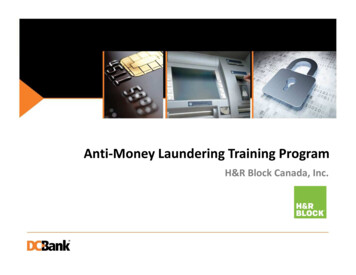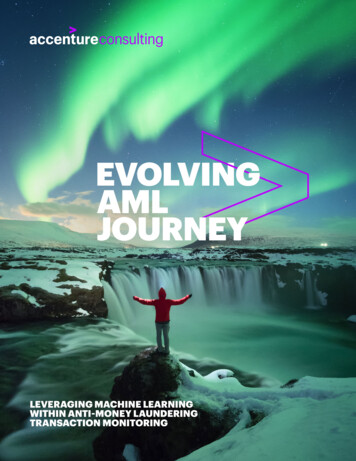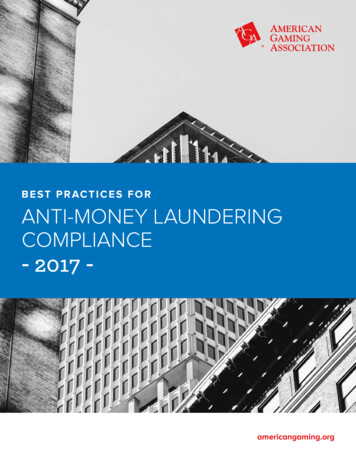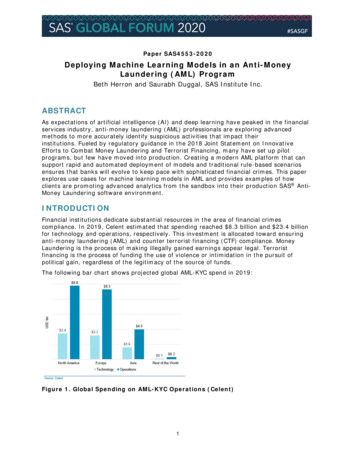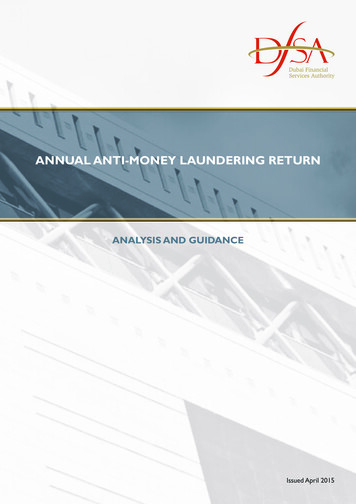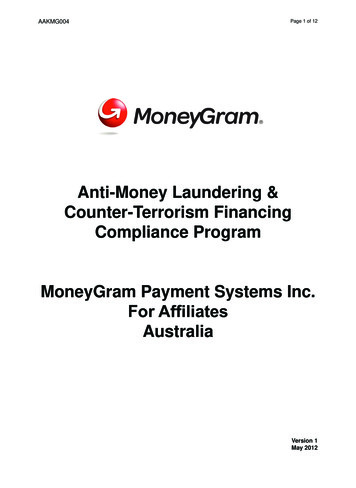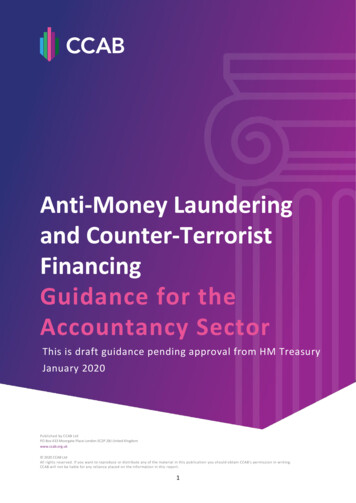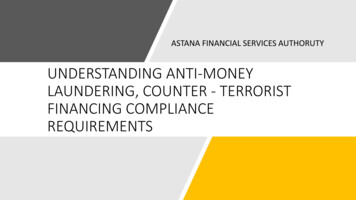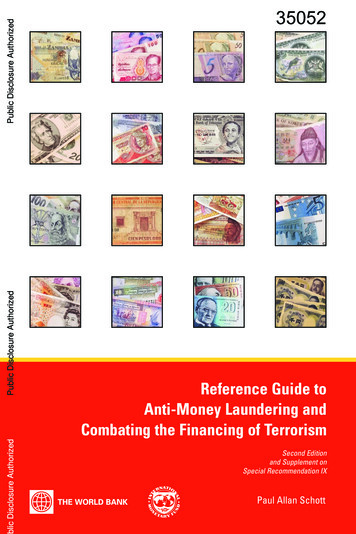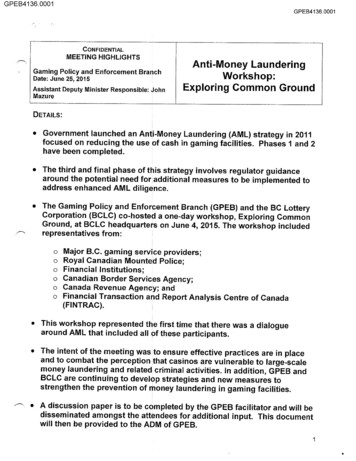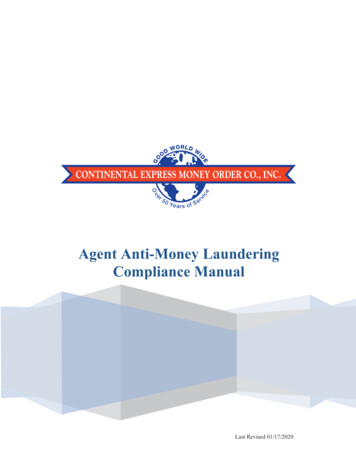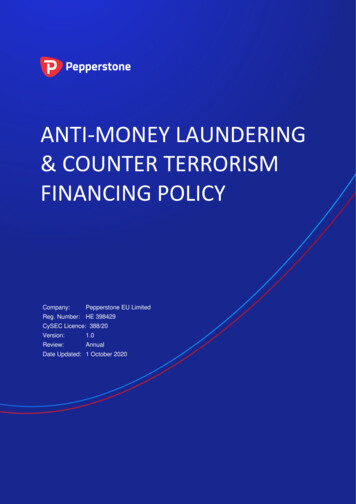
Transcription
ANTI-MONEYANTI-MONEY LAUNDERINGLAUNDERING& COUNTER &TERRORISMCOUNTERTERRORISMFINANCINGPOLICYFINANCING POLICYPepperstone LimitedCompany:Pepperstone EU LimitedReg. Number: HE 398429CySEC Licence: 388/20Version:1.0Review:AnnualDate Updated: 1 October 2020
www.pepperstone.comTable of Contents1. Introduction31.1 Scope31.2 Objective32. What is Money Laundering?2.1 Three Stages of Money Laundering44Placement4Layering4Integration43. What is Terrorist Financing?54. Responsibilities of AMLCO & Senior Management54.1 AMLCO54.2 Senior Management64.3 Employees Training75. Regulatory Responsibility76. Regulatory Framework76.1 Offences87. Risk-Based Approach97.1 Risks Identified97.2 How will the Company Mitigate Risks?97.3 Main components of the AMF and CTF framework for high risk clients8. Due Diligence8.1 Simplified and Enhanced Levels of Customer Due Diligence101011Simplified Due Diligence (SDD)11Enhanced Due Diligence118.2 Politically Exposed Persons (“PEPs”)128.3 Beneficial Ownership129. Suspicious Activity Reports1210. Sanctions Screening1310.1 Terrorist Lists1411. Monitoring, Management Information & Reporting1412. Ongoing Monitoring of Customer Activity1513. Training1614. Record-Keeping1615. Review of Policy16Appendix A: Money Laundering Suspicious Activity Report Form17
www.pepperstone.com1. IntroductionThis policy outlines Pepperstone EU Limited (“Pepperstone” or the “Company”) approach topreventing and detecting Money Laundering and Terrorist Financing. In developing thispolicy, Pepperstone considered all current Anti-Money Laundering (AML) and CounterTerrorist Financing (CTF) obligations required in the Cyprus Law 188(I)/2017 as amended (the“Law”), the 4th EU AML Directive as well as best regulatory guidance issued the CyprusSecurities and Exchange Commission “CySEC” in the form of Directives and Circulars.Pepperstone fully acknowledges that its products and services are at risk from individuals orgroups seeking to launder criminal proceeds or facilitate funds designated for the financingof terrorism. As such, Pepperstone is committed to fostering and promoting a complianceculture throughout the firm which underpins the importance of preventing MoneyLaundering and Terrorist Financing.Pepperstone recognises it has a statutory duty under Cyprus Law to prevent the facilitationof its services for Money Laundering and Terrorist Financing purposes. Subsequently,Pepperstone pledges to allocate sufficient resources into the firm’s internal controls,monitoring system, human resources and staff training to prevent financial crime.1.1 ScopeAll employees, directors, officers and associated agents are required to comply with thesepolicies. Failure to do so may result in disciplinary action.1.2 ObjectiveThe objectives of the policy are to: Emphasise our stringent commitment to preventing Pepperstone being used as aconduit to deposit, conceal and transfer criminal proceeds or funds intended fororchestrating terrorism. Summarise the main procedures, systems and controls Pepperstone has implementedto prevent and detect Money Laundering and Terrorist Financing. Clearly outline the responsibilities of the firm’s senior management, MoneyLaundering Reporting Officer (“MLRO”) and other key individuals in relation to thefirm’s AML/CTF strategy. Explain the most up-to-date Money Laundering and Terrorist Financing risks thatPepperstone is vulnerable to and how the firm intends to counteract these risks.
www.pepperstone.com Confirm that Pepperstone will take steps to monitor compliance with this policythroughout the firm.2. What is Money Laundering?Pepperstone views Money Laundering to be: ‘the process by which illegally gained proceedsor funds are cleansed and sanitised to disguise their illicit origins’.Criminal property may take any form, including money or money’s worth, securities, tangibleproperty and intangible property. It also includes money, however come by, which is used tofund terrorism.Money Laundering activity can include: Acquiring, using or possessing criminal property.Handling the proceeds of crimes such as theft, fraud and tax evasion.Being knowingly involved in any way with criminal property.Entering into arrangements to facilitate laundering criminal property.2.1 Three Stages of Money LaunderingThe Money Laundering process traditionally follows three stages:PlacementThe placement stage represents the initial entry of proceeds derived from illegal activity intothe financial system. It is during the placement stage when criminal transactions are mostvulnerable to detection.LayeringLayering is the most complex stage of the process, where criminals aim to separate the illegalproceeds from their illicit origin. This is traditionally done via several complex transactionswithin the international financial systems. It is common for criminals at this stage to transferfunds electronically between jurisdictions and invest them into advanced financial productsor overseas markets. This is done repeatedly to obscure the audit trail and decreases theprobability of law enforcement authorities tracing the proceeds to their original crime.IntegrationIt is at this final stage where the money is returned to the criminal as “clean” funds as theyappear to come from a legitimate source. Having been “placed” as cash and “layered” through
www.pepperstone.comseveral complex financial transactions, the criminal proceeds are now “integrated” into thefinancial system and can now be used for any purpose.3. What is Terrorist Financing?Pepperstone views Terrorist Financing to be: ‘The use of funds, or the making available offunds, for the purposes of terrorism.’ This constitutes the funds that both individuals andorganisations contribute towards financing terrorist activities or terrorist organisations.The source of terrorist financing can take many forms, including: Self-financing from individuals, including but not limited to income from employment,savings, borrowed money from families or friends and bank loans. Funds raised by legitimate charities affiliated to or sympathetic to terrorist ideology. States directly or indirectly sponsoring terrorist groups.Pepperstone is committed to ensuring that: Our clients are not terrorist organisations themselves. We are not providing the means through which terrorist organisations can be funded(i.e. by providing loans and other services to individuals who intend to financeterrorism).4. Responsibilities of AMLCO & Senior ManagementPepperstone clearly defines the roles and responsibilities of all individuals with oversight ofthe firm’s AML/CTF strategy and responsibility for the firm’s compliance with all AML/CTFrequirements.4.1 AMLCOPepperstone Board of Directors appoints a senior management individual as the Company’sAnti Money Laundering Compliance Officer (AMLCO). The AMLCO will assume responsibilityfor the firm’s AML/CTF strategy.It is the AMLCO’s responsibility to oversee the Company’s compliance with the MoneyLaundering regulations. The AMLCO is responsible for: Receiving and investigating internal reports relating to (suspicions of) MoneyLaundering and Terrorist Financing. Making reports of relevant suspicious activity to the Unit for Combating MoneyLaundering (MOKAS);
www.pepperstone.com Ensuring the suitability of the content of the AML & CTF training and the subsequentroll-out of the training to all staff and advisers across the firm. Reporting at least annually to the board on the operation and effectiveness of thefirm’s AML systems and controls. Responding promptly to any reasonable requests for information made by a regulatorof the firm. The approval and risk assessment of new or amended products/jurisdictions/saleschannels. Approving business relationships which the firm wishes to enter or continue wherethe consumer is a Politically Exposed Person (“PEP”). Approving business relationships which the firm wishes to enter or continue wherethe consumer resides in or trades with a jurisdiction which is considered by FinancialAction Task Force (FATF) as non-cooperative or has a high risk of terrorism. Establishing and maintaining policies, controls and procedures to mitigate andmanage effectively the risks of money laundering and terrorist financing identified inany risk assessment. Communicating the policies, controls and procedures which the firm establishes andmaintains in accordance with this regulation to relevant personnel of the Company.Appointment of Alternate AML Compliance Officer In accordance with CySEC AML Directive, Pepperstone should appoint an AlternateAML Compliance Officer, to temporarily replace the AMLCO when the AMLCompliance Officer is absent. It is clarified that the provisions of paragraph 8 of theDirective do not apply when the AML Compliance Officer resigns from his position,since in such case Pepperstone is required to appoint a new AML Compliance Officer,always subject to CySEC prior notification and approval as required by the applicablelaw and the CySEC AML Directive. Pepperstone is required to inform CySEC and submit the name, position and contactdetails of the Alternate AML Compliance Officer.4.2 Senior ManagementPepperstone appoints a Board member to assume responsibility for the firm’s compliancewith the Anti-Money Laundering regulatory framework (the “AML Director”).
www.pepperstone.comOverall, Pepperstone’s AML Director together with senior management is responsible for: Ensuring that the firm’s AML/CTF policies, procedures and controls are appropriatelydesigned and implemented to reduce the firm’s vulnerability to Money Launderingand Terrorist Financing. Being fully engaged in the decision-making process regarding the firm’s AML/CTFstrategy and take ownership of their risk-based approach. Being involved in the design of the firm’s policies, procedures and controls andapproving them. Being aware of the level of Money Laundering and Terrorist Financing risk the firm issubject to. Ensuring that the firm fulfils their obligations under the Cyprus AML Law, the 4th AMLDirective and CySEC related Directive and Circulars.4.3 Employees TrainingAll Pepperstone’s employees are trained to identify and report suspicious activity. They arealso given regular training on the law relating to Money Laundering and Terrorist Financing.5. Regulatory ResponsibilityPepperstone EU Limited is registered with the CySEC, licence number 388/20.6. Regulatory FrameworkPepperstone is fully aware of the Cyprus and EU regulatory framework relating to AML andCTF. Pepperstone also provides regular training to our employees, agents and subsidiaries toensure they have sufficient knowledge of the applicable regulatory framework.Pepperstone is required to adhere to the following legislation and regulations: Directive (EU) 2015/849 (4th AML Directive) of the European Parliament and of theCouncil and Directive (EU) 2018/843 amending Directive (EU) 2015/849 The Prevention and Suppression of Money Laundering and Terrorist Financing Laws of2007-2019 (Law 188(I)/2007 and subsequent amendments) CySEC Directive for the Prevention and Suppression of Money Laundering andTerrorist Financing “the Directive” Any Circulars and guidelines issued by CySEC in relation to Anti-Money Launderingsuch as Circulars CI1442014-25, C033, C292, C296, C299, C300, C303, C307, C314,C317, C318, C319, C337, C339 and C367.
www.pepperstone.com Guidance of other relevant global bodies such as The Joint Money Laundering SteeringGroup (JMLSG) Guidance is also considered as a consulting tool.6.1 OffencesThe above legislation and regulations outline multiple Money Laundering and TerroristFinancing offences, which Pepperstone is committed to avoiding. The key offences under theapplicable legislation and regulation, which are subject of up to a maximum of 14-yearimprisonment and/or a fine of up to EUR 500.000 are as follows: Concealingo It is an offence to help conceal, disguise, convert, transfer or remove fundsfrom the Republic of Cyprus if you know, should have known, suspect orshould have suspected that the funds were the proceeds of criminalconduct. Arrangementso It is an offence to enter into or become concerned with an arrangement ifyou know, should have known, suspect or should have suspected that thearrangement facilitates the acquisition, retention, use or control ofcriminal property. Acquisition, use and possession of fundso Regardless of any attempt to conceal or disguise the criminal origin ofproperty, it is an offence to acquire, use or possess criminal property. Thisoffence does not require the laundering process to be actively undertaken. Tipping Offo It is an offence for anyone to take any action likely to prejudice aninvestigation by informing the person who is the subject of a suspiciousactivity report, or anybody else, that a disclosure has been made, or thatthe police. MOKAS or any other relevant authorities are carrying out orintending to carry out a Money Laundering investigation. Failure to Reporto It is an offence to ‘blind eye’ to money laundering by making it a criminaloffence for persons working in the regulated sector to fail to report wherethey have knowledge, suspicion or reasonable grounds for knowledge orsuspicion that another person is engaged in Money Laundering.
www.pepperstone.com Laundering Terrorist Propertyo It is an offence to enter into or become concerned in an arrangementwhich facilitates the retention or control of terrorist property byconcealing, removing it from the jurisdiction, transferring it to nomineesor in any other way.7. Risk-Based ApproachPepperstone applies a risk-based approach with regards to its AML/CTF strategy and routinelyidentifies and assesses the Money Laundering and Terrorist Financing risk the business isexposed to.As required under the Anti-Money Laundering regulatory framework, Pepperstone willconduct a regular risk assessment to examine all risks of Money Laundering and TerroristFinancing to which to business is subject. In assessing and identifying such risks, the firm willtake into consideration the following factors: Risks posed by the firm’s clients.Products and services offered by the firm.The geographical areas of the firm’s clients.Delivery channels the firm uses.The volume and complexity of the client’s transactions.Once the risks have been identified and assessed, Pepperstone pledges to amend its policies,procedures and controls in accordance with the underlying risks.7.1 Risks IdentifiedPepperstone has conducted a risk assessment to identity the most potent Money Launderingand Terrorist Financing risks for the which the firm is vulnerable. A full list of risks identifiedby the firm in its most recent risk assessment can be found in the AML and CTF RiskAssessment.7.2 How will the Company Mitigate Risks?Pepperstone has implemented numerous measures to counteract the risk of MoneyLaundering and Terrorist Financing through the firm. A full list of risks identified by the firmin its most recent risk assessment can be found in the AML and CTF Risk Assessment.
www.pepperstone.com7.3 Main components of the AMF and CTF framework for highrisk clientsConcerning the Money Laundering and Terrorist Financing threat that certain designatedhigh-risk clients pose, Pepperstone will apply a four-component framework to enhance itsAnti-Money Laundering actions.The four main components that Pepperstone will apply are as follows:Customer Due DiligenceUndertake enhanced customer due diligence measures before entering into a transaction orbusiness relationship or during a business relationship with a designated high-risk person.Ongoing MonitoringUndertake enhanced ongoing monitoring of any business relationship with a designated highrisk person.Systematic ReportingCollect enhanced information and documents and perform enhanced reporting to seniormanagement in relation to transactions and business relationship with a high-risk person.Limiting or Ceasing BusinessDo not enter or discontinue a transaction or business relationship with a high-risk personwhen directed by the AMLCO or Senior Management.8. Due DiligencePepperstone is required to undertake appropriate due diligence measures across its customerbase to ensure the firm has undertaken a comprehensive appraisal of all potential customers.To do this, the firm will establish and verify their identity, assets, the nature and intendedpurpose of the relationship and liabilities. Pepperstone adopt a risk-based approach todetermine the level of due diligence required for each type of customer and the potentialMoney Laundering and Terrorist Financing risk they pose to the business.In evaluating the risk level of each customer, Pepperstone will consider risk factorssurrounding the customer, the product/service they are acquiring, the anticipated frequencyand volume of transactions and their geographical location.
www.pepperstone.com8.1 Simplified and Enhanced Levels of Customer Due DiligencePepperstone will conduct distinct levels of due diligence depending on the outcome of eachcustomer’s risk assessment (i.e. low, medium, or high risk):Simplified Due Diligence (SDD)SDD is the lowest level of due diligence that can be completed on a customer. Beforeconducting SDD on a customer, a degree of risk assessment is required to demonstrate thatthe customer presents a lower degree of risk and requires suitable ongoing monitoring. Assuch, SDD is reserved for customers who present a low risk of money laundering or terroristfinancing and where this low risk can be evidenced.When applying “SDD” we need to verify customer’s identity and comprise the risk profile ofthe customer. To complete “SDD”, the customer’s ID must be sought. This could includePepperstone requesting a physical copy of the customer’s government issued ID and/or byperforming electronic Know Your Customer (“KYC”) checks. Further we need to obtain at leasta Proof of Address (POA) document.When the client is categorised as Medium risk the ID verification is enhanced by requestingan additional ID document from the client for cross reference and requesting informationabout the customer’s source of wealth/funds.Should there be any doubt about the validation of the customer’s identity, Enhanced DueDiligence measures should be undertaken.Enhanced Due DiligenceEnhanced Due Diligence (“EDD”) will be required when the risk assessment has ascertainedthat the customer poses a high risk of Money Laundering to mitigate the increased risk to thebusiness. This includes, but is not limited to, customers that are or may be Politically ExposedPersons and/or Sanctioned individuals.In addition, customers found to be residing in/transferring to high risk countries andcustomers performing large or complex transactions that cannot be explained whenconsidering the client’s transaction history will also be subject to EDD by Pepperstone.What EDD entails will be dependent on the nature and severity of the identified heightenedrisk. This could include, but is not limited to, obtaining additional ID evidence, ID verification,and a full description of source of wealth and funds, internet searches for potential negativescreening, verifying additional information from the customer about the purpose and
www.pepperstone.comintended nature of the transaction or the business relationship and after establishing therelationship, increasing the frequency and intensity of transaction monitoring.All EDD customers must be approved by Pepperstone’s AMLCO before the relationship isfinalised and before any transactions take place.Individuals or legal entities sanctioned by the EU or the UN are not accepted as clients.8.2 Politically Exposed Persons (“PEPs”)When a valid PEP, or family member or close associate of a PEP, has been identified,Pepperstone’s AMLCO is required to approve the initiation of the bespoke businessrelationship. This includes the continuation of a relationship with an existing client who maybe identified as a PEP following the initial client on-boarding process. If Pepperstone identifiesa PEP, the firm will conduct EDD measures determined on a risk-sensitive basis.Pepperstone agrees with the definition of PEP given by the Financial Action Task Force (FATF),and the 4th EU AML Directive which is: ‘an individual who is or has been entrusted with aprominent public function’.Pepperstone will initially be made aware of a potential PEP status as a result of the AMLchecks which is completed across the firm’s entire customer base and during the initial onboarding process. Pepperstone will then conduct a full media search on the potential PEPbefore assessing whether it is a ‘true match’. The results of this search are to be submitted tothe AMLCO for consideration.8.3 Beneficial OwnershipA “beneficial owner”, is defined as the individual who ultimately owns or controls the entity(in general with a percentage of 25% or more) or arrangement on whose behalf a transactionis being conducted. The regulatory framework places an obligation on financial institutions toidentify and verify the identity of any beneficial owner of any entity on whose behalf atransaction is being conducted.9. Suspicious Activity ReportsPepperstone’s AMLCO must report to the Unit for Combating Money Laundering (MOKAS)any transaction or activity that, after their evaluation, they know or suspect, or havereasonable grounds to know or suspect, may be linked to Money Laundering and TerroristFinancing. This is done by means of a Suspicious Transaction Report (“STR”). Such reports
www.pepperstone.comshould be made as soon as is reasonably practicable upon receiving the notification ofsuspicion. Pepperstone’s AMLCO must consider each report of suspicious activity from withinthe firm and determine whether it gives rise to knowledge or suspicion, or reasonablegrounds for the knowledge or suspicion of Money Laundering or Terrorist Financing. Anyapproach to the customer or to the intermediary should be made sensitively by someoneother than the AMLCO, to minimise the risk of alerting the customer or an intermediary thata disclosure to the MOKAS is being considered. Under no circumstance, is the individualunder suspicion to be informed of a pending investigation.Pepperstone fully understands that it is an offence to “tip-off” (i.e. inform) a person suspectedof Money Laundering that an AML investigation in their business relationship or transactionsis taking place. All relevant staff have been made aware of the penalties for tipping-off andpotentially jeopardising an AML investigation. For further clarity regarding tipping-off, pleasecontact the firm’s AMLCO.When considering an “Internal Suspicion Report”, the AMLCO should make every endeavourto collect as much information as possible regarding the customer/transaction but in theinterest of timely reporting, may need to consider making an initial report prior to the fullreview of linked/connected relationships and transactions.Internal Suspicion Reports to the AMLCO must be made regardless of whether the transactionhas taken place. In some instances, it may be necessary for the AMLCO to obtain consent fromthe MOKAS prior to continuing with the transaction.A templated “Internal Suspicion Report” has been included as Appendix A.10. Sanctions ScreeningPepperstone is required to comply with the European Union (EU) and the United Nations (UN)financial sanctions regime and recognises its responsibility to deny services and products toindividuals who pose a significant Money Laundering and Terrorist Financing risk to theinternational financial system.To comply with the regime, Pepperstone screens all persons being on-boarded by the firmagainst the most up-to-date consolidated list of sanctions targets issued by the EU or the UN.Pepperstone then also screens all clients on a weekly basis to ensure someone has not beadded to the sanction list after they have been onboarded as a client. Pepperstone alsoallocates adequate resources on areas of the business that carry a greater likelihood ofinvolvement with targets or their agents. As part of the firm’s controls, Pepperstone monitorspayment instructions to ensure that proposed payments to targets or their agents are notmade.
www.pepperstone.comPepperstone pays close attention to jurisdictions which have been earmarked byinternational organisations, such as FATF, as having AML/CTF regimes considered to bestrategically deficient. FATF frequently publishes documentation available on its websiteswhich identifies and evaluates such jurisdictions.FATF uses these publications to signal to its members and other jurisdictions to applycountermeasures to protect the international financial system from the ongoing andsubstantial money laundering and terrorist financing risks emanating from these countries.FATF publishes a list of jurisdictions which have strategic AML/CFT deficiencies for which theyhave developed an action plan with FATF. This list can be found at: oncooperativejurisdictions/?hf 10&b 0&s desc(fatf releasedate)10.1 Terrorist ListsThe acts of terrorism committed against the USA in September 2001 have increased theinternational efforts to locate and cut off funding for terrorists and their organisations.Terrorists often control funds from a variety of sources around the world and employincreasingly sophisticated techniques to move those funds between jurisdictions. In doing so,they require the services of skilled professionals such as bankers, accountants and lawyers.The sites below confirm lists of international w.fbi.gov/wanted/wanted terroristsPepperstone understands it is an offence to provide financial services to any suspected orknown terrorists and implements measures to prevent this eventuality.11. Monitoring, Management Information & ReportingPepperstone’s AMLCO must ensure that all systems, controls, policies and procedures are upto-date and compliant to the regulatory framework.At least once in each calendar year, the firm’s AMLCO will provide a report to the governingbody and senior management. The report must include the following:
www.pepperstone.com Review of the effectiveness of the firms AML systems and controls, with appropriaterecommendations for improvement in the management of risks and priorities,including resources. Detail those within the firm responsible for AML systems and controls. Concluding actions and the remedial progress in response to these is to be stored in asecure location central to the business. It must indicate the way in which new findings on countries with AML inadequacieshave been used during the year. The number of internal reports made by staff.Pepperstone’s senior management will give these reports due consideration and takenecessary actions to remedy any deficiencies identified by the report.The firm has an obligation to regularly update the CySEC on the systems and controls we havein place to prevent financial crime and how the firm mitigates the risk of financial crime. Assuch, Pepperstone’s AMCLO is required to submit the annual AMLCO report to the CySEC.The policies, procedures and controls that Pepperstone have in place are regularly amendedand enhanced in accordance with updates to legislation, regulation, and industry bestpractice. Our systems and controls also change to counteract the risks identified by the firmin its regular risk assessments. Subsequently, Pepperstone has systems in place to monitorstaff compliance with the firm’s policies, procedures and controls.12. Ongoing Monitoring of Customer ActivityPepperstone is required to conduct ongoing monitoring of the business relationship with allof its customers. As per the regulatory guidance, this ongoing monitoring entails: Scrutiny of transactions undertaken throughout the course of the relationship(including source of funds) to ensure the transactions are consistent with the firm’sknowledge of the customer. Ensuring that the documentation obtained for the purpose of applying Client DueDiligence remains up to date.It is essential for the firm’s monitoring system to have the following features: Flags up transactions for further examination. These transactions are reported to and reviewed promptly by the authorisedperson(s). Appropriate action is taken on the findings of any further review.Pepperstone’s monitoring system for customer activity is based on the following risk factors:
www.pepperstone.com The unusual nature of the transaction. E.g. an abnormally large transaction notconsistent with the firm’s knowledge of the customer. The number of a series of transactions. E.g. many small transactions initiated in quicksuccession. The geographical destination or origin of a payment. E.g. a payment to a high-riskjurisdiction. The parties concerned. E.g. a request to make payment to or from a person on asanctions list.A full list of Pepperstone’s ongoing monitoring systems and methods can be observed in theAML and CTF Risk Assessment.13. TrainingAll staff and contractors of Pepperstone should be made aware of the laws and regulationssurrounding Money Laundering and Terrorist Financing, how to identify suspicious activity,and the obligations placed on the firm. They should also be aware of who has been appointedas the firm’s AMLCO.All staff require training covering the firm’s procedures and how to recognise and deal withsuspected Money Laundering or Terrorist Financing concerns.Staff training records are to be retained and evidenced on each individual employee’sContinual Professional Development (“CPD”) Log alongside the firm’s central training log.Records are required to be retained for five years.14. Record-KeepingIn line with the EU regulatory framework, Pepperstone will retain customer information forfive years following the termination of a business rel
Being aware of the level of Money Laundering and Terrorist Financing risk the firm is subject to. Ensuring that the firm fulfils their obligations under the Cyprus AML Law, the 4th AML Directive and CySEC related Directive and Circulars. 4.3 Employees Training All Pepperstones employees are trained to identify and report suspicious activity.
